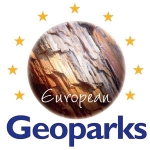European Geopark Network (EGN)
Aims of the EGN

Although geology is always the main area of promotion in geoparks, network members adopt a holistic approach to the promotion of our natural and cultural heritage. Furthermore all members consider full local community involvement as essential to our success.
There is a variety of activities that can be considered typical of a geopark. Most are either geotourism– or educational-based, including schools programmes, guided walks and museum exhibitions. Geological heritage protection and promotional activities are also essential activities of a geopark. Socio-economic activities in geoparks are important for sustainable regional development. Geoparks adopt a holistic approach to their heritage and promote all aspects of their regions natural and cultural heritage.
How the EGN operates
![]()

The network operates primarily by continuous electronic communication, frequent coordination meetings, annual conferences and the establishment of common projects through which territories can exchange ideas, experience and best practice thereby supporting each other to fulfil our common goals.
The structure of the network is relatively simple and comprises an Advisory Committee (12 members including representatives of UNESCO, IUGS and IUCN) and a Coordination Committee (comprising of two representatives from each member). Decisions concerning the network are only made by the Coordination Committee. As part of the Co-ordination Committee there is an elected EGN Co-ordinator and Vice Co-ordinator to represent the whole network. They co-ordinate contacts with other international bodies (E.U, UNESCO, IUGS, IUCN, Council of Europe etc.) and prepare the agenda of the meetings in partnership with the meeting host.
Relationship with UNESCO
In 2001 the European Geoparks Network signed a formal agreement with the Division of Earth Sciences UNESCO whereby UNESCO gave the network its endorsement. A further agreement was signed with UNESCO in 2004 whereby the EGN was given responsibility for regulating membership of the UNESCO Global Network of Geoparks in Europe.
The Burren and Cliffs of Moher Geopark became the 44th member of the EGN in September 2011.
Why are both the Burren and Cliffs of Moher combined under the Geopark status?
Though both offer completely different visitor and landscape experiences, the two places are nature-forged neighbours – connected by geography and people. Both places powerfully influence each other socially and economically. The Cliffs of Moher attraction delivers a significant impact on tourism in the wider region. Its management and marketing strategy actively promotes the greater Burren region as a very special destination. It has in turn embraced the use of model sustainable tourism practices adopted elsewhere in the Burren. Taken together, the Cliffs of Moher and the Burren is a convincing example of what can be achieved when people, enterprises and organisations work constructively in common cause. Each can learn from, and benefit, the other – and the wider community.